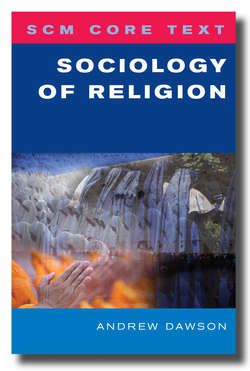Читать книгу SCM Core Text Sociology of Religion - Andrew Dawson - Страница 33
На сайте Литреса книга снята с продажи.
Polythetic definitions
ОглавлениеIn contrast to Spiritism and certain other non-mainstream movements, Scientology is keen to be labelled a ‘religion’. Not necessarily wishing to become involved in the ongoing legal-political machinations in respect of this desire, the majority of sociologists who work in this area nevertheless tend towards the view that Scientology, like Spiritism, exhibits a sufficient range of typical characteristics to justify its academic recognition as ‘religion’ (Lewis, J., 2009). While both substantive and functional definitions of religion are brought to bear in cases such as Scientology (Beckford, 1980; Frigerio, 1996), social scientists are increasingly using what are termed ‘polythetic’ or ‘multi-factorial’ approaches. I have already used this type of approach when arguing above that Spiritism, irrespective of what its adherents claim, should be regarded as religion on the grounds that it exhibits a sufficient number of characteristics which are taken to be typical of what we understand a religion to be and do.
Also known as the ‘family resemblance’ model, the polythetic (literally, ‘many attributes or themes’) approach to defining religion starts from the premise that no single definition can adequately capture what is, in its actual manifestations, a highly varied phenomenon. As no single concept or theory is able to capture sufficiently the variegated character of religion, polythetic approaches attempt to define religion through an inventory of its most commonly occurring characteristics. Those phenomena adjudged to have a sufficient number of these characteristics (share an adequate number of ‘family resemblances’) are thereby acknowledged to belong to the category of ‘religion’. Alston, for example, includes nine ‘religion-making characteristics’ in his definition of religion (1967, pp. 140–7), while Southwold lists twelve such ‘attributes’ (1978, pp. 362–79).
According to Southwold, for example, ‘the word “religion” designates cultural systems which have at least some of these attributes’:
(1) A central concern with godlike beings and men’s relations with them. (2) A dichotomization of elements of the world into sacred and profane, and a central concern with the sacred. (3) An orientation towards salvation from the ordinary conditions of worldly existence. (4) Ritual practices. (5) Beliefs which are neither logically nor empirically demonstrable or highly probable, but must be held on the basis of faiths . . . (6) An ethical code, supported by such beliefs. (7) Supernatural sanctions on infringements of that code. (8) A mythology. (9) A body of scriptures, or similarly exalted oral traditions. (10) A priesthood, or similar specialist religious elite. (11) Association with a moral community, a church (in Durkheim’s sense . . .) (12) Association with an ethnic or similar group. (1978, pp. 370–1)
The strength of the polythetic model resides in its ability to offer an inclusive definition of religion which readily reflects the actual variety of religious belief and practice evident across the globe. Provided the list of characteristics/resemblances is not allowed to become too long, the inclusivity offered by this approach need not come at the expense of the analytical precision required of all definitions; that is, they should indicate not only what a thing is but also what it is not.
What polythetic approaches such as those of Alston and Southwold do not do, however, is indicate just how many of the characteristics listed should be identified before any particular set of practices and beliefs can be classified as ‘religion’. Presumably this number should not be so low as to suffer from the same weaknesses of singular definitions such as Tylor’s, but nor should it be so high as to become too demanding and thereby too exclusive. Nor do Alston and Southwold say if any of these characteristics are more important than any of the others and thereby carry more weight in the definitional stakes. For example, and in reference to Southwold’s list, does a particular set of beliefs and practices in possession of characteristics 1, 4 and 10 enjoy a more secure categorization as ‘religion’ than one exhibiting numbers 3, 5 and 12? Finally, and as with every other attempt to define religion to date, polythetic approaches offer only a superficial (‘thin’) description of the subject at hand. Although covering more ground by virtue of their inclusive approaches, the lists of Alston and Southwold still leave undefined just what is meant by terms such as ‘religious feelings’ and ‘ritual’ – terms which make sense only when fleshed out with detailed (‘thick’) descriptions of actual processes which occur in particular socio-cultural contexts. While a fact of life rather than a technical failing, the need to define further the constituent parts of lists such as these serves to underline that no matter how seemingly inclusive a definition appears, it still requires an element of interpretation; interpretation which is, by its nature, always a view from a particular socio-cultural point.
